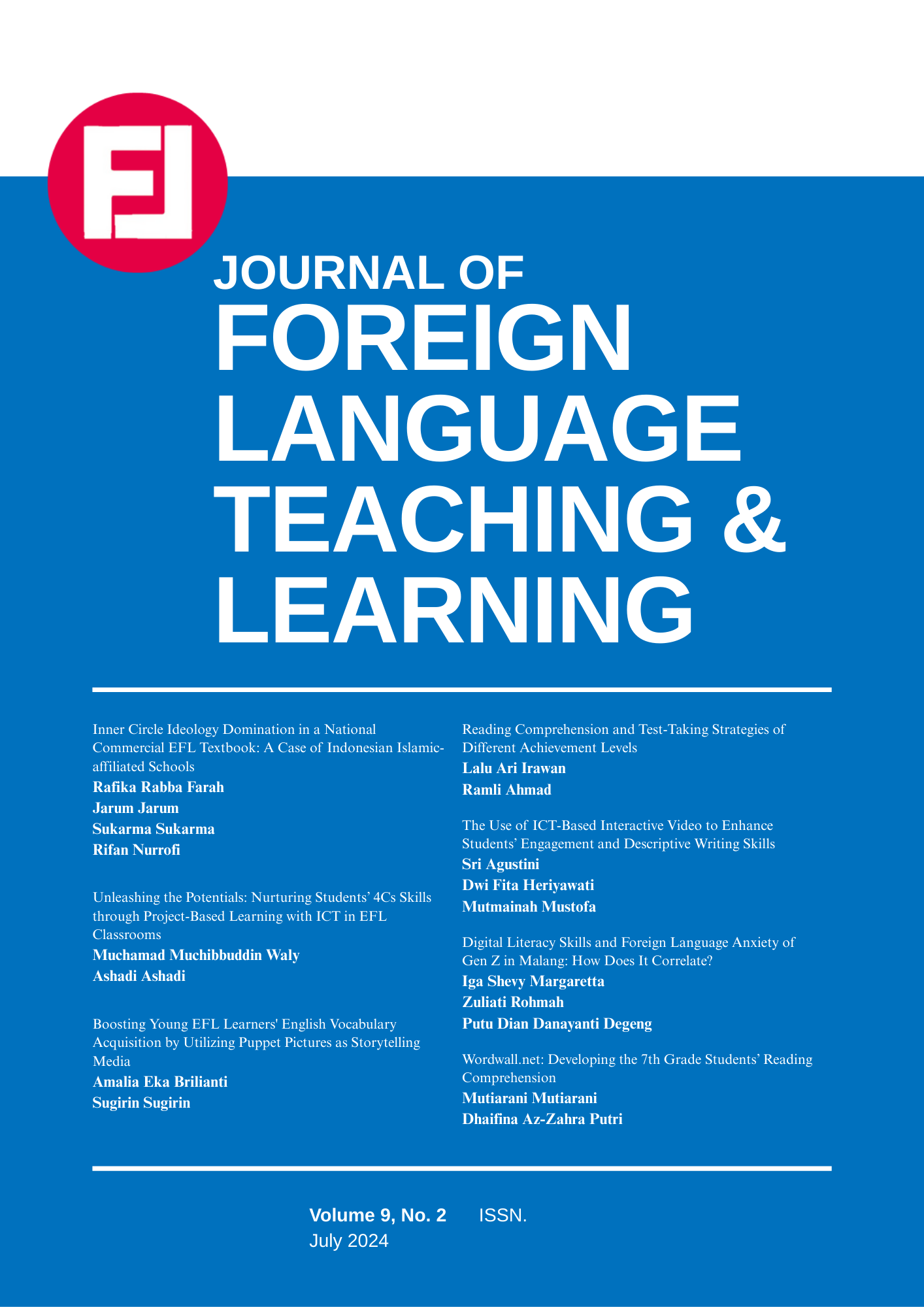Boosting Young EFL Learners' English Vocabulary Acquisition by Utilizing Puppet Pictures as Storytelling Media
DOI:
https://doi.org/10.18196/ftl.v9i2.21622Keywords:
Vocabulary Acquisition, Puppet Picture Media, StorytellingAbstract
Students' interest becomes the most important aspect of successful teaching and learning. One way to attract students' interest in participating in the lesson is by using fun learning media like puppet pictures. This study explores how employing puppet pictures as a storytelling and sharing medium can improve students' vocabulary acquisition. The present study employed a pre-experimental approach to assess the vocabulary proficiency level achieved through puppet image storytelling media. The group, which had a pre-test and post-test, was considered a single sample for teaching using puppet visuals and storytelling medium. The research subjects consisted of first-grade students enrolled at Ariya Metta Elementary School. The evaluation instruments utilized consisted of a pre-test and post-test, designed based on phase A of the Merdeka curriculum. These instruments were employed to evaluate the enhancement or notable increase in vocabulary scores, employing puppet image narrative media. The pre-test and post-test data were calculated using a statistical analysis program. The data statistics from the descriptive analysis and matched sample statistics showed that the average score of the pre-test (57.86) increased to the post-test score (88.57). In addition, the paired sample T-test yielded a p-value of 0.000, less than the significance level of 0.05. The result indicates that the Null Hypothesis (Ho) was rejected, and the alternative hypothesis (Ha) was accepted. Ultimately, puppet storytelling media had a significant impact on enhancing pupils' vocabulary development.References
Afzal, N. (2019). A study on vocabulary-learning problems encountered by BA English Majors at the university level of education. Arab World English Journal, 10(3), 81–98. https://doi.org/10.24093/awej/vol10no3.6
Ahern, A., Garcia Bermejo, M. L., & Fleta, T. (2007). Storybooks in the young learners’ EFL classroom as a resource for teaching vocabulary. Estudios de Linguistica Inglesa Aplicada (ELIA), 7(January), 35–51.
Al-Harbi, S. S. (2020). Language development and acquisition in early childhood. Journal of Education and Learning (EduLearn), 14(1), 69–73. https://doi.org/10.11591/edulearn.v14i1.14209
Al-Shamsi, A. S. (2021). Cognitive and metacognitive skills on elementary school students: mixed methods study. Tesol International Journal, 16(6), 141–159. https://www.tesol-international-journal.com/journal-index/2021/
Cameron, L. (2001). Teaching Languages to Young Learners. Cambridge University Press. https://doi.org/10.1017/CBO9780511733109
Clyne, M., & Sharifian, F. (2008). English as an international language. Australian Review of Applied Linguistics, 31(3), 28.1-28.16. https://doi.org/10.2104/aral0828
Copland, F., Garton, S., & Burns, A. (2014). Challenges in teaching english to young learners: Global perspectives and local realities. TESOL Quarterly, 48(4), 738–762. https://doi.org/10.1002/tesq.148
Gao, L. (2022). Nature versus nurture in bilinguals’ language acquisition. Proceedings of the 2021 International Conference on Education, Language and Art (ICELA 2021), 637(Icela 2021), 451–453. https://doi.org/10.2991/assehr.k.220131.082
Hepburn, E., Egan, B., & Flynn, N. (2010). Vocabulary acquisition in young children: The Role of the story. Journal of Early Childhood Literacy, 10(2), 159–182. https://doi.org/10.1177/1468798410363754
Kamil, D. (2021). Measuring Indonesian EFL learners’ English vocabulary knowledge: A Rasch Analysis Approach. Edukasi: Jurnal Pendidikan Dan Pengajaran, 8(2), 169–180. https://doi.org/10.19109/ejpp.v8i2.11091
Kandia, I. W., Suarningsih, N. M., Wahdah, W., Arifin, A., Jenuri, J., & Suwarma, D. M. (2023). The strategic role of learning media in optimizing student learning outcomes. Journal of Education Research, 4(2), 508–514. https://jer.or.id/index.php/jer/article/view/193
Kröger, T., & Nupponen, A. M. (2019). Puppet as a pedagogical tool: A literature review. International Electronic Journal of Elementary Education, 11(4), 393–401. https://doi.org/10.26822/iejee.2019450797
Laufer, B., & Aviad–Levitzky, T. (2017). What type of vocabulary knowledge predicts reading comprehension: Word meaning recall or word meaning recognition? The Modern Language Journal, 101(4), 729–741. https://doi.org/10.1111/modl.12431
Laufer, B., & Paribakht, T. S. (1998). The relationship between passive and active vocabularies: Effects of language learning context. Language Learning, 48(3), 365–391. https://doi.org/10.1111/0023-8333.00046
Losi, R. V., Tasril, V., Widya, R., & Akbar, M. (2022). Using storytelling to develop English vocabulary on early age children measured by Mean Length of Utterance (MLU). International Journal of English and Applied Linguistics (IJEAL), 2(1), 179–187. https://doi.org/10.47709/ijeal.v2i1.1470
Luthfiana. (2021). Puppet pictures as storytelling media to teach English vocabulary for young learners. Economics, Social, and Humanities Journal, 1(1), 1–13. https://jurnal.unupurwokerto.ac.id/index.php/esochum
Mandarsari, P. (2023). Online authentic materials in teaching English for EFL students. International Journal of Research on English Teaching and Applied Linguistics, 4(1), 65–78. https://doi.org/10.30863/ijretal.v4i1.5013
Marpaung, M. S., & Situmeang, H. J. P. (2020). Enhancing students’ vocabulary through authentic materials and multimedia. Acuity: Journal of English Language Pedagogy, Literature and Culture, 5(2), 1–16. https://doi.org/10.35974/acuity.v5i2.2247
Maskor, Z. M., & Baharudin, H. (2016). Receptive vocabulary knowledge or productive vocabulary knowledge in writing skill, which one important? International Journal of Academic Research in Business and Social Sciences, 6(11), 261–271. https://doi.org/10.6007/IJARBSS/v6-i11/2395
Miyazaki, K. (2019). The effect of an online vocabulary learning tool on passive and active vocabulary use at a range of proficiency levels. Journal of Pan-Pacific Association of Applied Linguistics, 23(1), 85–108. https://doi.org/10.25256/paal.23.2.5
Nosidlak, K. M. (2013). Vocabulary learning strategies of the advanced students. Journal of Language Teaching and Research, 4(4), 655–661. https://doi.org/10.4304/jltr.4.4.655-661
Pateşan, M., Balagiu, A., & Zechia, D. (2019). Vocabulary acquisition. International Conference Knowledge-Based Organization, 25(2), 300–304. https://doi.org/10.2478/kbo-2019-0098
Prayudha, J. (2021). Improving students’ English skill by using the papets (paper puppets) learning media. International Conference on Education and Technology, 1(1), 1–9.
Rafiqa, R. (2017). The English vocabulary acquisition of the students of state junior high school 2 Parepare. EDUVELOP, 1(1), 18–35. https://doi.org/10.31605/eduvelop.v1i1.8
Rahmi, A. A., Anjani, I. D., Aristiana, D., Kusmawardani, D., & Muahad, H. (2020). The effectiveness of teaching vocabulary by using puppet at SDIT Az-Zahra Dendang-Stabat. Jurnal Ilmiah Mahasiswa, 1(1), 58–68. https://doi.org/https://doi.org/10.1016/j.addr.2018.07.012%0
Rohmatillah. (2014). A study on students’ difficulties in learning vocabulary. English Education: Jurnal Tadris Bahasa Inggris, 6(1), 69–86. https://doi.org/http://dx.doi.org/10.24042/ee-jtbi.v6i1.520
Viera, R. T. (2017). Vocabulary knowledge in the production of written texts: A case study on EFL language learners. Revista Tecnológica ESPOL-RTE, 30(3), 89–105. https://rte.espol.edu.ec/index.php/tecnologica/article/view/628
Wedana, I. M. L., Suarnajaya, W., & Adnyani, L. D. S. (2019). The effect of puppets as teaching media on the speaking competency. Jurnal Penelitian Dan Pengembangan Sains Dan Humaniora, 3(2), 128. https://doi.org/10.23887/jppsh.v3i2.21277
Widiastuty, H., Normuliati, S. N., Yuliana, N. M. Y., Firmansah, Y. F., & Indriyani, S. I. (2024). The assistance for learning English vocabulary using finger puppets. Jurnal Inovasi Pengabdian Masyarakat Pendidikan, 4(2), 336–351. https://doi.org/10.33369/jurnalinovasi.v4i2.28627
Yulianti, R., & Latief, M. A. (2014). Puppet and pop up pictures as the story telling media. TEFLIN International Conference, 61(2007), 900–905.
Zuhriyah, M. (2017). Storytelling to improve student’s speaking skill. English Education: Jurnal Tadris Bahasa Inggris, 10(1), 119–134.
Downloads
Published
How to Cite
Issue
Section
License
Copyright
Authors retain copyright and grant the journal right of first publication with the work simultaneously licensed under a Creative Commons Attribution-ShareAlike 4.0 International License that allows others to share the work with an acknowledgment of initial publication in this journal.
Authors are permitted and encouraged to post their work online (e.g., in institutional repositories, social media account, or on their website) after the article getting published in the journal, as it can lead to productive exchanges and earlier and greater citation of published work (See The Effect of Open Access).License
You are free to:
- Share — copy and redistribute the material in any medium or format
- Adapt — remix, transform, and build upon the material for any purpose, even commercially.
Attribution — You must give appropriate credit, provide a link to the license, and indicate if changes were made. You may do so in any reasonable manner, but not in any way that suggests the licensor endorses you or your use.
ShareAlike — If you remix, transform, or build upon the material, you must distribute your contributions under the same license as the original.
- No additional restrictions — You may not apply legal terms or technological measures that legally restrict others from doing anything the license permits.



.png)





